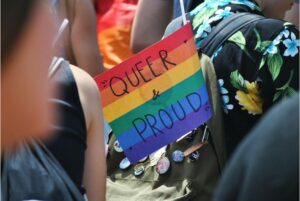Shirtless men held hands and openly kissed as they march New York streets on June 28th, 1970. The first pride parade, organized by a bisexual woman named Brenda Howard, vibrated with both celebration and protest. Exactly one year after the historic Stonewall Riots, the marchers sought to use slogans such as “Gay is Okay” and “Gay Power” to shed the shame brought on by discrimination and prejudice. Every year since, pride parades continue to grow in number and size to overcome the pervasive shame LGBTQ+ people face.
DBT argues that every emotion, including shame, plays a role in achieving our goals, building connection, and fostering insight. When determining what to do with emotion, especially one as powerful and potentially painful as shame, DBT encourages us to determine (1) if it fits the facts and (2) if expressing the emotion is effective.

When does shame fit the facts? According to DBT, shame fits the facts when we need to hide something about ourselves or else we’ll be rejected by our community. This makes sense because the word “shame” comes from an ancient word meaning “to cover.” At times, disclosing sexual orientation or gender identity could lead to being rejected by family, religion, or community, so the feeling of shame fits the facts in these cases. Does this mean that being queer is shameful or that problematic structures in the environment need to change? Other times, people are very pleasantly surprised when they come out and receive a wave of acceptance and excitement.
When shame fits the facts, we ask the second question: is it effective to express shame? Shame helps us “fit in” and can be very effective in small doses when in new situations such as starting a job or visiting another country. Humility, which can be considered a less intense version of shame, allows us to continue to learn new things, consider different perspectives, and overall prevent us from getting too big for our britches.
 So if shame fits the facts, is it effective to listen to this emotion by staying in the closet and covering up our identities? There is no simple or easy answer to this. Relying on our internal wisdom (aka Wisemind) can help us make the seemingly impossible decision about whether to come out or not. If expressing the feeling of shame is effective, we are faced with the immensely heavy burden of concealing our identity. I urge anyone in this position to please find support because many find staying in the closet is an unsustainable solution. Using problem solving and being mindful of emotions can help make the current community more accepting or find a more accepting community.
So if shame fits the facts, is it effective to listen to this emotion by staying in the closet and covering up our identities? There is no simple or easy answer to this. Relying on our internal wisdom (aka Wisemind) can help us make the seemingly impossible decision about whether to come out or not. If expressing the feeling of shame is effective, we are faced with the immensely heavy burden of concealing our identity. I urge anyone in this position to please find support because many find staying in the closet is an unsustainable solution. Using problem solving and being mindful of emotions can help make the current community more accepting or find a more accepting community.
If shame does not fit the facts and/or is not effective to express, DBT encourages us to practice opposite action by doing the exact opposite of the emotion. Going completely and utterly against the action urge of shame looks like making the seemingly shameful thing public, adopting a confident body posture, and refusing to apologize. And each pride parade is a beautiful, rainbow-filled, glitter-covered, dancing in the streets act of opposite action. Since 1970, LGBTQ+ people have been fighting back shame by parading in the streets and proudly declaring that “Gay is Okay.” Through their efforts, we can continue to reduce stigma and shame by accepting those around us and refusing to apologize for who we are.

